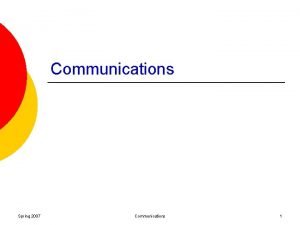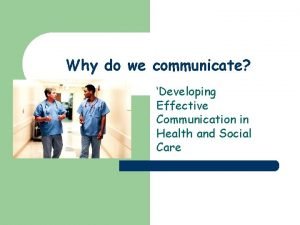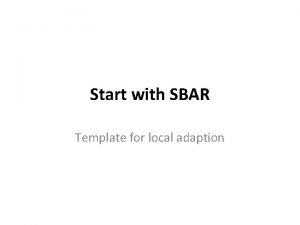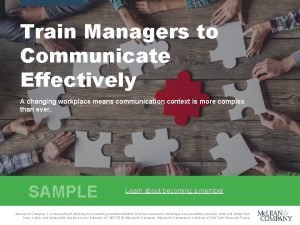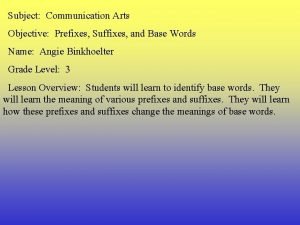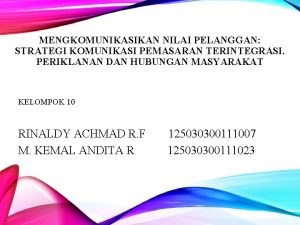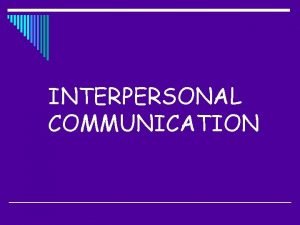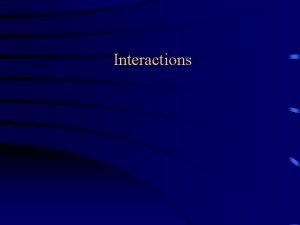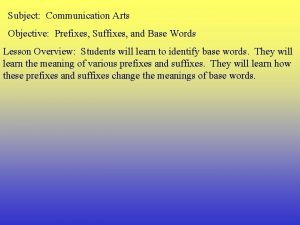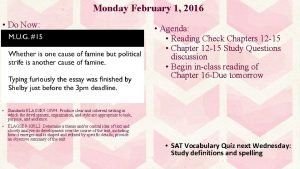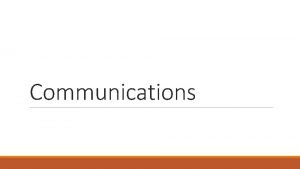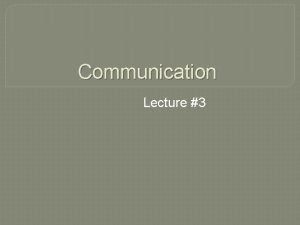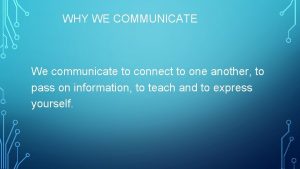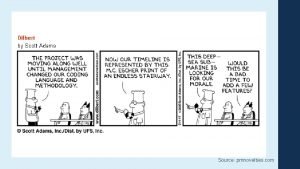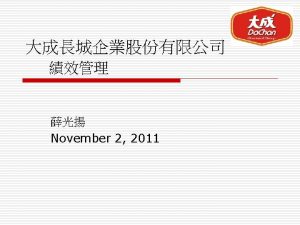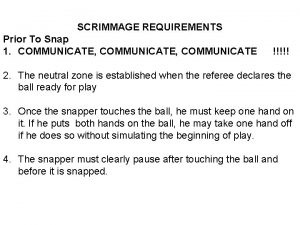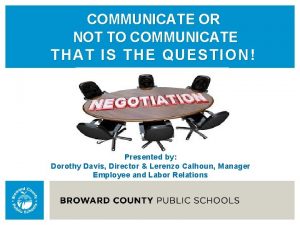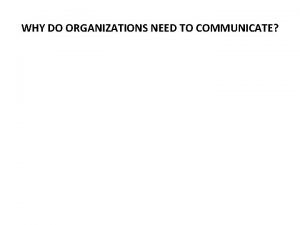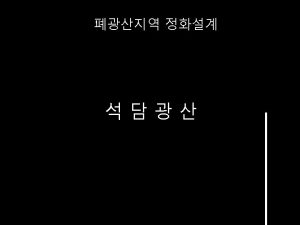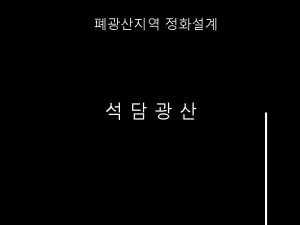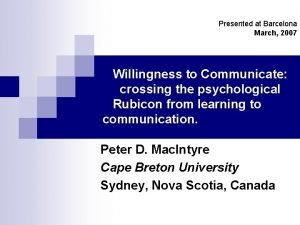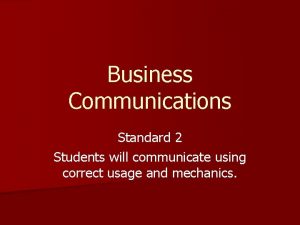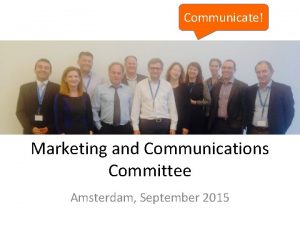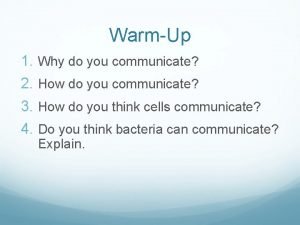Communications Spring 2007 Communications 1 Communications Why communicate





























- Slides: 29

Communications Spring 2007 Communications 1

Communications • Why communicate? • The communications process and characteristics • Barriers to effective communications • Improving communications Spring 2007 Communications 2

Why Communicate? • • • Spring 2007 To convey information To receive information To determine what information needs to be sent or obtained To gain acceptance for your ideas To motivate other people To maintain relationships with coworkers, clients, etc. To establish trust To keep people involved in a project To produce action or change To understand the wants and needs of your stakeholders To express your emotions or feelings Communications 3

The Communications Process Sender Noise Barriers Message Barriers Feedback Spring 2007 Receiver Communications 4

Encoding Issues • Standardized encoding procedure • Financial reporting • Encoding to deceive • Deliberate deception / fraud • “Spin” Spring 2007 Communications 5

Spin in the Want-Ad "IMMEDIATE OPENING" The person who used to have this job gave notice a month ago. We're just now running the ad. " SALES POSITION REQUIRING MOTIVATED SELF-STARTER "We're not going to supply you with leads; there's no base salary; you'll wait 30 days for your first commission check. COMPETITIVE ENVIRONMENT "We have a lot of turnover. " MUST BE DEADLINE ORIENTED "You'll be six months behind schedule on your first day. " DUTIES WILL VARY "Anyone in the office can boss you around. " NO PHONE CALLS PLEASE "We've filled the job; our call for resumes is just a legal formality. " Spring 2007 Communications 6

Types of Communications • Forms of communication • Verbal • Written • Non-verbal • To Whom • • • Spring 2007 Immediate coworkers Supervisor / subordinates Others within own organization Customers and clients Suppliers / vendors Communications 7

Communications Channels • • • Spring 2007 Face-to-face Telephone Grapevine E-mail Memos, letters Formal reports Communications 8

Channel Richness • A channel’s ability to transmit information, including the ability to handle multiple cues simultaneously, encourage feedback, and focus personally on the receiver. • Why Is It Important? • More cues (i. e. , words, tone of voice, and non-verbals) allow more information to be transmitted • Feedback ensures that listener has opportunity to obtain additional information or clarify any uncertainties • Personal focus permits customizing message and encourages listener attention Spring 2007 Communications 9

Channel Richness: Specific Channels High Channel Richness Phone call Memos, Letters Low Channel Richness Spring 2007 Face to face E-mail, voicemail Formal Report Communications 10

Non-Verbal Communications • • Spring 2007 Voice Appearance Face and eyes Posture and movement Personal space and distance Time Physical environment Communications 11

Barriers to Communications • • • Spring 2007 Information overload Noise Language Filtering Selective perception Defensiveness Communications 12

Information Overload • Multiple communications • • • Phone and voicemail Email Pager Cellphone Reports and memos • What price peace and quiet ? ? Spring 2007 Communications 13

Noise • Physical noise and distractions • Environment (cold, heat, dust) • Preoccupations Spring 2007 Communications 14

Language Issues • • Spring 2007 Actual language Accents, etc. Volume and speed Jargon Communications 15

Filtering • Sending on the news you think your audience wants to hear • Impression management • What happens to the messenger bringing bad news…. . . Spring 2007 Communications 16

Perception Spring 2007 Communications 17

Selective Perception • Stereotypes • Women are fluffy, Asians good with math, etc. • Halo Effect • Generalizing from one aspect of the person to another; she’s sloppily dressed, therefore, she’s not too bright • Projection • Assuming one’s own motives apply to others; he’s not too honest, so he assumes others will not be, either. Spring 2007 Communications 18

More Perceptual Errors • Primacy and Recency Effects • Bad / good first impressions or most recent perceptions • Perceptual Readiness • We hear what we expect or want to hear or what we’re told to hear. For example, if you're told the professor is good, you’ll perceive her favorably. • Perceptual Defense • We ignore threatening information. Spring 2007 Communications 19

Attribution • I’m creative • You’re disorganized • He’s a slob. • Also, external and internal attributions for success and failure • I failed because of circumstances; you failed because you didn't try Spring 2007 Communications 20

Defensiveness • A response to perceived threat or criticism • What is it? • Personal attacks • Sarcasm • Questioning motives Spring 2007 Communications 21

Supportive and Defensive Climates Spring 2007 SUPPORTIVE DEFENSIVE • • • Description Problem Orientation Spontaneity Empathy Equality Provisionalism Communications Evaluation Control Strategy Neutrality Superiority Certainty 22

The Three Hardest Things to Say I Was Wrong I Don’t Know I Need Help Spring 2007 Communications 23

Improving Communications • Listening • Openness • Feedback Spring 2007 Communications 24

The Levels of Listening Level 1: Unrelated Response “I had a bad accident yesterday, but nobody was hurt” Level 2: Tangential Response Level 3: Furthering Response Level 4: Feeling Response Spring 2007 Communications “Did you hear that Ed and Mary are getting married? ” “Cars are a pain; my air is out. ” “Were you on Nonconnah when it happened? ” “I know you must be relieved to be safe” 25

How to Listen • • • Spring 2007 Stop talking. You cannot listen if you are talking ! Put the talker at ease. Show the talker that you want to listen. Remove distractions. Empathize. See the situation from the other person’s point of view. Be patient. Hold your temper. Go easy with arguments and criticisms. When you argue, even if you win, you lose. Ask questions to show interest and encourage response. Stop Talking. This is both first and last, because all other guides depend on it. Communications 26

How to Listen Nature gave people two ears but only one tongue, which is a gentle guide that they should listen more than they talk. Listening requires two ears, one for meaning and one for feeling. Decision makers who do not listen have less information for making sound decisions. Spring 2007 Communications 27

Giving Effective Feedback Spring 2007 WEAKNESSES STRENGTHS • • • • Evaluative Do it indifferently General Uncontrollable Late Analyze Negative only Punish Communications Descriptive Feelings evoked Specific Controllable Timely Effect Positive and negative Help 28

Receiving Effective Feedback Spring 2007 STRENGTHS WEAKNESSES • • • Elicit Listen Check Clarify Ask others Communications Wait Wonder Assume Justify Discount 29
 Pictures
Pictures The heavenly banquet
The heavenly banquet Channel richness
Channel richness Why do we communicate
Why do we communicate Why communicate
Why communicate Four seasons korean movie
Four seasons korean movie Spring winter summer fall
Spring winter summer fall Don't ask why why why
Don't ask why why why Why is spring force conservative
Why is spring force conservative Inform persuade entertain
Inform persuade entertain Sbar template word
Sbar template word Jesip model
Jesip model How do people communicate
How do people communicate What does effective communication look like
What does effective communication look like Meaning of effective communication
Meaning of effective communication How do people communicate
How do people communicate Pathological fractire
Pathological fractire Training managers to communicate effectively
Training managers to communicate effectively Suffix of communication
Suffix of communication Communicate value
Communicate value Interpersonal communication is complicated
Interpersonal communication is complicated Objects communicate with one another by using
Objects communicate with one another by using Prefix and suffix for communicate
Prefix and suffix for communicate New system communicate let us know
New system communicate let us know Tkam chapter 27-31 summary
Tkam chapter 27-31 summary How dogs communicate
How dogs communicate Persons in lpscs careers must effectively communicate with
Persons in lpscs careers must effectively communicate with How do processes communicate
How do processes communicate When we communicate verbally we should use
When we communicate verbally we should use Talking aloud to oneself with no intent to communicate
Talking aloud to oneself with no intent to communicate


